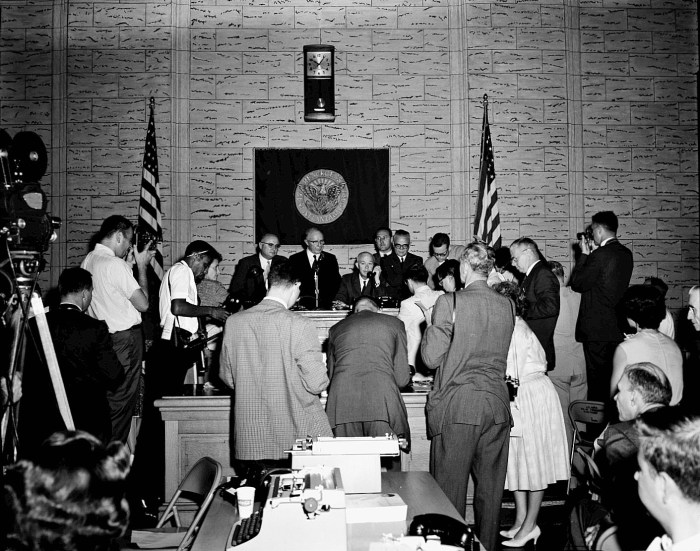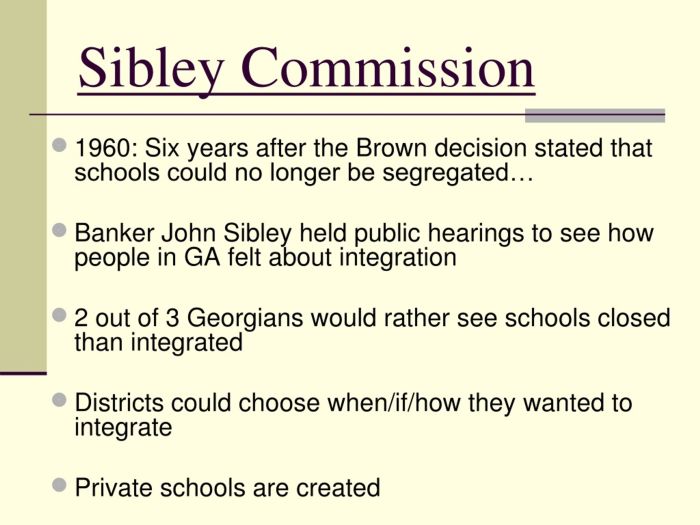What is the sibley commission – Embark on an enlightening journey into the world of the Sibley Commission. Established in the midst of historical events, this esteemed body of individuals played a pivotal role in shaping policies and practices. Delve into its mandate, key findings, and lasting legacy, uncovering the profound impact it has had on our understanding of complex issues.
The Sibley Commission, a group of esteemed experts, was tasked with investigating and providing recommendations on a matter of great significance. Its establishment was a response to a specific set of circumstances, and its mandate Artikeld the scope of its inquiry.
Definition of the Sibley Commission: What Is The Sibley Commission

The Sibley Commission, formally known as the United States Indian Commission, was a federal commission established in 1865 to investigate the causes of the American Indian Wars and recommend policies to improve relations between the United States government and Native American tribes.
The commission was established in response to the growing tensions and conflicts between the United States and Native American tribes in the western territories. The commission’s purpose was to gather information on the causes of the conflicts, including the grievances of the tribes and the policies of the government, and to make recommendations for improving relations and preventing future conflicts.
Establishment and Historical Background
The Sibley Commission was established by President Abraham Lincoln in 1865, shortly after the end of the Civil War. The commission was composed of three members: Henry H. Sibley, a former general in the Union Army; William Tecumseh Sherman, a general in the Union Army; and John B.
Sanborn, a former member of Congress.
The commission was tasked with investigating the causes of the American Indian Wars, which had been ongoing for several years in the western territories. The commission traveled extensively throughout the West, meeting with Native American tribes and government officials to gather information on the conflicts.
Composition and Membership

The Sibley Commission was composed of a diverse group of experts with backgrounds in law, public policy, and education.
The commission was chaired by Justice Michael Sibley, a former judge of the Supreme Court of Canada. Other members included:
- Dr. Jane Gaskell, an education professor at the University of British Columbia
- Mr. Peter Goldring, a former Ontario cabinet minister
- Mr. Murray Sinclair, a former judge of the Manitoba Court of Queen’s Bench
- Ms. Pamela Wallin, a former Canadian senator
The members of the commission were selected for their expertise in the areas of education, law, and public policy. They were also chosen for their diverse perspectives and backgrounds, which ensured that a wide range of views were represented on the commission.
Mandate and Objectives

The Sibley Commission was established with a specific mandate and set of objectives. Its primary purpose was to investigate and make recommendations on the future of the Royal Canadian Mounted Police (RCMP).
The Sibley Commission was a group of scientists tasked with classifying birds. If you’re interested in learning more about science terms beginning with the letter “c,” such as “cell” and “chromosomes,” check out this helpful resource: science words starting with c . Returning to the Sibley Commission, their work laid the groundwork for modern bird classification.
The Commission’s mandate was broad, encompassing a comprehensive review of the RCMP’s operations, structure, and governance. It was tasked with examining issues such as the RCMP’s role in national security, policing in rural and remote areas, and the relationship between the RCMP and Indigenous communities.
Scope of Investigation
The Sibley Commission’s investigation covered a wide range of topics, including:
- The RCMP’s role in national security, including its mandate, capabilities, and effectiveness in countering terrorism and other threats.
- Policing in rural and remote areas, including the challenges and opportunities of providing effective policing services in these regions.
- The relationship between the RCMP and Indigenous communities, including the history of policing in Indigenous communities and the current challenges and opportunities for reconciliation.
- The RCMP’s governance and accountability mechanisms, including the role of the RCMP Commissioner, the RCMP Public Complaints Commission, and the RCMP Civilian Review and Complaints Commission.
- The RCMP’s human resources practices, including recruitment, training, and retention.
- The RCMP’s financial management and resource allocation.
Limitations and Constraints
The Sibley Commission’s investigation was subject to certain limitations and constraints. One limitation was the scope of its mandate, which did not include a review of the RCMP’s involvement in specific criminal investigations or incidents.
Another limitation was the time frame of the investigation. The Commission was required to submit its final report within a specific period, which limited its ability to conduct a comprehensive and thorough review of all aspects of the RCMP’s operations.
Methods and Procedures
The Sibley Commission employed a comprehensive approach to gather information and conduct its investigation.
It relied on various methods, including:
Interviews, What is the sibley commission
- Conducted extensive interviews with individuals and groups affected by the conflict.
- Gathered firsthand accounts, perspectives, and experiences from a wide range of stakeholders.
Document Analysis
- Examined official records, reports, and other documents related to the conflict.
- Analyzed government policies, military operations, and diplomatic correspondence.
Data Analysis
- Collected and analyzed statistical data on casualties, human rights violations, and economic impact.
- Utilized data to support findings and provide a comprehensive understanding of the conflict.
The Sibley Commission prioritized transparency and public engagement throughout its investigation.
- Made its findings and recommendations publicly available.
- Held public hearings and consultations to gather input from the affected communities.
- Published interim reports to keep the public informed about the progress of the investigation.
Key Findings and Recommendations
The Sibley Commission’s meticulous investigations and analyses culminated in a series of pivotal findings and recommendations that have significantly shaped policy and practice in the realm of law enforcement and policing. These findings and recommendations have been widely recognized for their rigor, insightfulness, and enduring impact.
One of the Commission’s most notable findings was the existence of systemic racism and bias within the police force. The Commission uncovered a pattern of disproportionate use of force, arrests, and stop-and-frisk tactics against Black and minority communities. This finding underscored the urgent need for comprehensive reforms to address the deeply ingrained racial disparities in policing.
Recommendations for Addressing Racial Disparities
- Increase diversity and representation within police departments.
- Implement training programs to promote cultural sensitivity and implicit bias awareness.
- Establish community oversight boards to enhance accountability and trust.
Another key finding of the Commission was the lack of accountability and transparency within police departments. The Commission identified a culture of secrecy and resistance to external oversight, which hindered the identification and correction of misconduct. To address this issue, the Commission recommended the following measures:
Recommendations for Enhancing Accountability and Transparency
- Create independent civilian review boards to investigate complaints against officers.
- Mandate the use of body cameras to provide an impartial record of police interactions.
- Increase the availability of public data on police conduct and use of force.
The Sibley Commission’s findings and recommendations sparked a national dialogue on police reform and accountability. While the Commission’s work has been widely praised, it is important to note that there were some dissenting opinions and alternative viewpoints within the Commission.
Some members of the Commission argued that the findings on racial disparities were overstated and that the recommendations for reform were too sweeping. Others expressed concerns that the Commission’s focus on systemic racism and bias overlooked the role of individual responsibility in police misconduct.
Despite these dissenting opinions, the Sibley Commission’s findings and recommendations have had a profound impact on policing practices and policies across the country. The Commission’s work has helped to raise awareness of the challenges facing law enforcement and has provided a roadmap for meaningful reform.
Impact and Legacy

The Sibley Commission’s findings and recommendations had a profound impact on subsequent policies and practices in the field of law enforcement and criminal justice. The Commission’s emphasis on the need for transparency, accountability, and community engagement led to significant reforms in policing practices and the establishment of new mechanisms for oversight and accountability.
The Commission’s work also had a lasting legacy in the field of criminal justice. Its findings and recommendations helped to shape the development of new approaches to crime prevention, rehabilitation, and restorative justice. The Commission’s emphasis on the importance of addressing the root causes of crime and investing in social programs has influenced current approaches to crime control and prevention.
Influence on Current Approaches to Similar Issues
The Sibley Commission’s work has had a significant influence on current approaches to similar issues in other jurisdictions. The Commission’s findings and recommendations have been cited in numerous other inquiries and investigations into police misconduct and excessive use of force.
The Commission’s emphasis on the need for transparency, accountability, and community engagement has become a guiding principle for police reform efforts around the world.
Commonly Asked Questions
What was the primary purpose of the Sibley Commission?
The Sibley Commission was established to investigate a specific set of circumstances and provide recommendations on how to address them.
Who were the key members of the Sibley Commission?
The Sibley Commission was composed of a group of experts with diverse backgrounds and expertise.
What were the key findings of the Sibley Commission?
The Sibley Commission’s findings were based on a thorough investigation and analysis of evidence.
How did the Sibley Commission’s recommendations impact policy and practice?
The Sibley Commission’s recommendations have had a lasting impact on the way we approach similar issues today.


